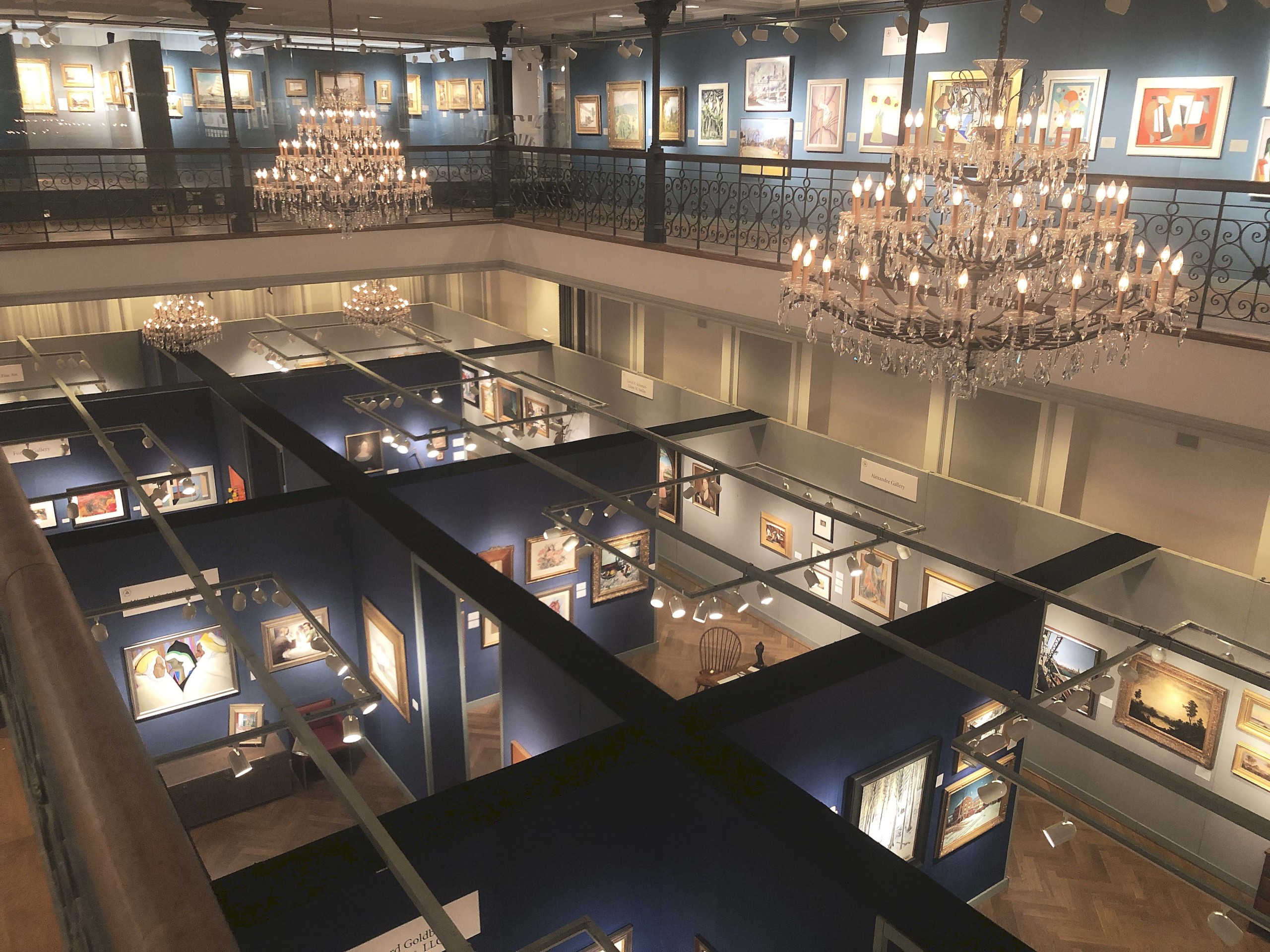
The view of the fourth floor, taken from the fifth floor. Photo courtesy The American Art Fair.
Review & Onsite Photos by Madelia Hickman Ring
NEW YORK CITY — Students of American art history who want to inspect and even handle museum-quality works and talk to knowledgeable dealers and scholars in the field would be well-advised to attend the annual American Art Fair, held every year in early May at the Upper East Side’s Bohemian National Hall. For its 17th annual edition on May 11-14, the show presented 17 dealers showing every conceivable genre: portraits, still life paintings, landscapes and historical paintings in media that ranged from oil to watercolor to acrylic two-dimensional works and three-dimensional pieces in bronze, marble and wood. Spanning the Eighteenth to the Twenty-First Century, most regional areas and movements were represented. The show more than holds its own against the behemoth auction previews and the spring edition of TEFAF, which took place at the Park Avenue Armory.
Catherine Sweeney Singer, the show’s director, reported, “We exceeded last year’s record in attendance and sales, with nearly 600 guests at the preview, including dozens of museum curators. We had record attendance Monday and Tuesday, standing room only at most of our lectures and more than 50 sales by midafternoon on the fair’s last day, with follow-up sales in the coming weeks.”
Thomas Colville Fine Art, the show’s founder, and Avery Galleries take up the entirety of the top floor, giving them a prime view down onto the dealers exhibiting on the fourth floor. Colville’s offerings bridged both the Nineteenth and Twentieth Century and included recently acquired works by George Inness (1825-1894), Emil Bisstram (1895-1976) and Charles Biederman (1906-2004), Werner Drewes (1899-1985) and Milton Avery (1885-1965). During the show, the Guilford, Conn., dealer sold “Young Boy with White Ruffled Collar” by William Merritt Chase (1849-1916) and Guy C. Wiggins’ (1883-1962) “Winter on the Avenue.”
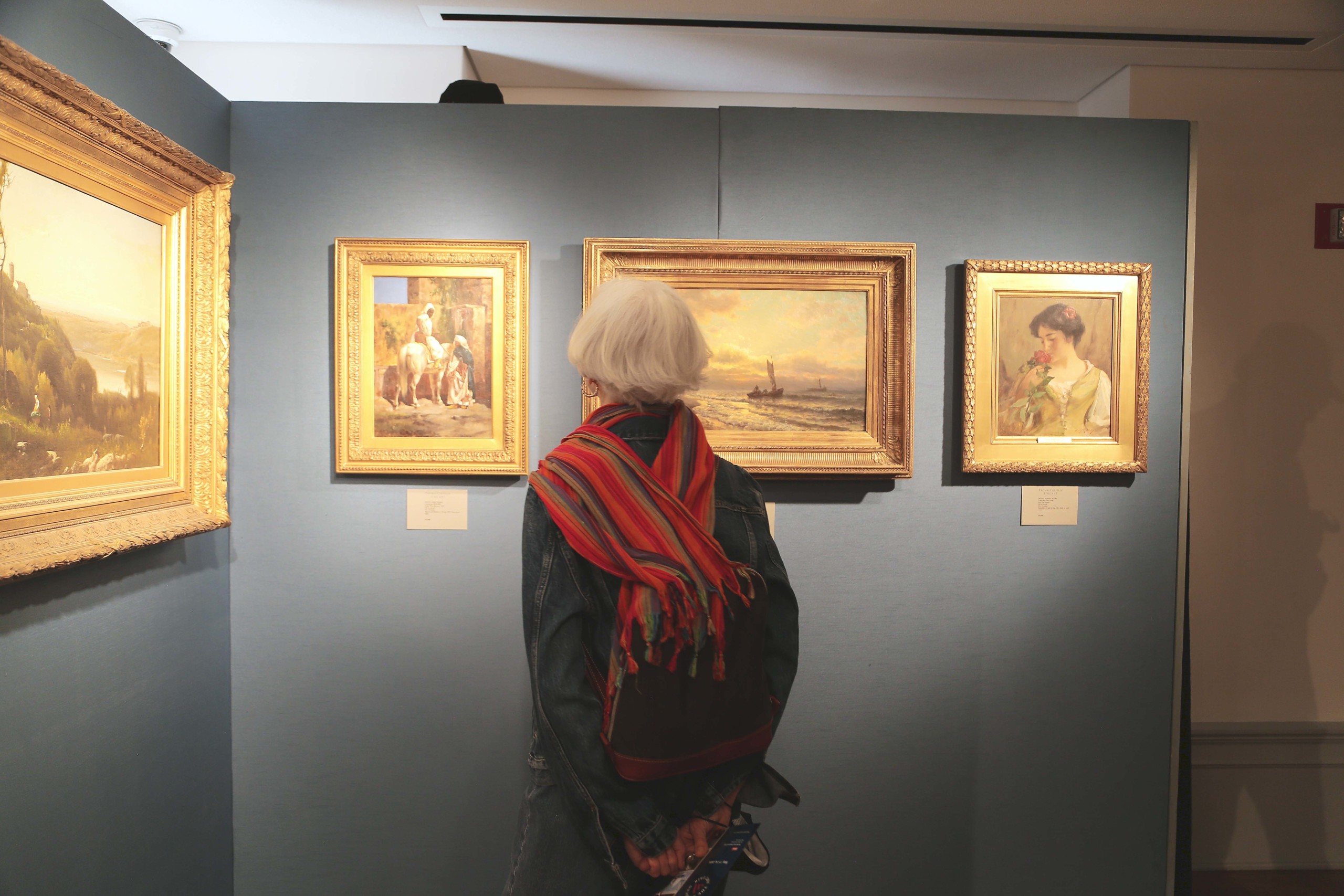
This fair attendee stood for more than five minutes looking at “At the Well, Morocco” by Edwin Lord Weeks (1849-1903), in the corner of Thomas Colville’s fifth floor booth. Guilford, Conn.
Colville attributes the success of the fair “as an oasis of focused quality in a plethora of jumbled impressions created by the mega auctions on view at the same moment in which periods, nationalities and grades of quality are presented simultaneously in overwhelming quantity. Our free admission and knowledgeable, friendly exhibitors contribute to our relaxed, focused and inviting atmosphere.”
Avery Galleries had, after the first two days of the fair, sold a couple of things, a 1910 portrait by Joseph de Camp (1858-1923) titled “The Fur Jacket” and, by Frederick John Mulhaupt (1871-1938), “A Skipper and his Mate, Gloucester,” also from 1910. The gallery, which has shops in New York City and Bryn Mawr, Penn., would sell an additional four works, including two by Joseph Stella (1877-1946), one by Provincetown, Mass., artist Blanch Lazelle (1878-1956) and another by Jonas Lie (1880-1940).
Hirschl & Adler’s booth is the first one that visitors saw as they stepped off the elevator on the fourth floor. Debuting at the show were two Twentieth Century works: William Bailey’s (1930-2020) “Still Life” (1980) and “An Odyssey for Moderns” by O. Louis Guglielmi (1906-1956), which had been exhibited in multiple venues and published in Encyclopedia Britannica Collection of Contemporary American Painting (1946).
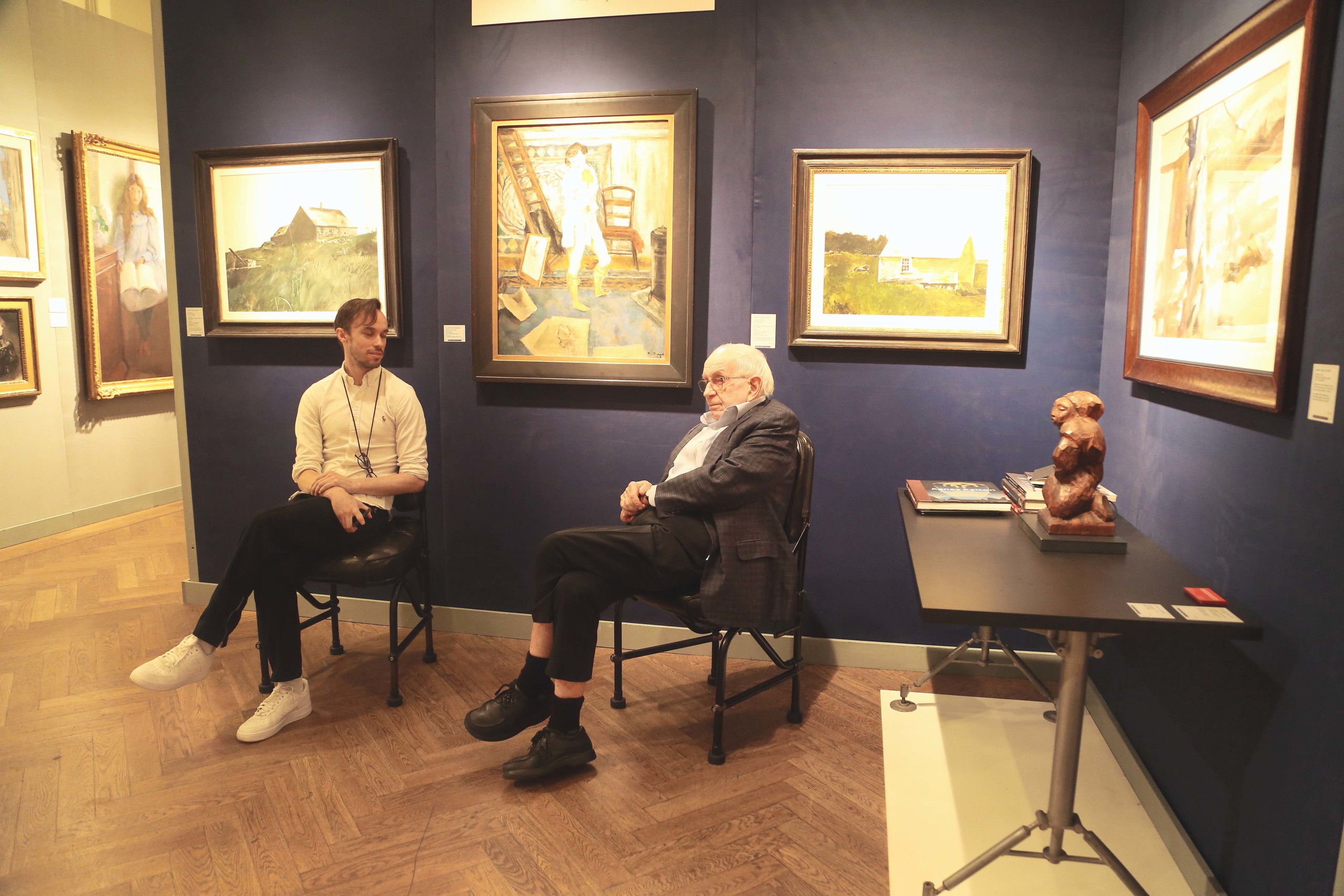
Ken Sims and Bernard Goldberg seated below Andrew Wyeth’s “At Teels” (left) and “The New Camp” (right) and Alexander Brook’s “The Artist’s Model” (center). Bernard Goldberg Fine Arts, New York City.
Around the corner from Hirschl & Adler, Bernard Goldberg Fine Art had a choice variety of paintings, drawings and sculpture. Holding pride of place in the center of the booth was William Zorach’s (1889-1966) “Seated Dancer,” carved in 1950 in pink Tennessee marble, that had provenance to the estate of the artist. Two brilliantly colored landscapes by Hugh Breckenridge (1870-1937) were paired with a landscape by Thomas Anshutz (1851-1912) that had a similar palette. Holding court on one wall was “French Circus” by Julian Levi (1900-1982), Wood Gaylor’s (1883-1957) 1911 study for “The Boardwalk” and Robert Henri’s (1865-1929) regal portrait from 1924 titled “Lady from Madrid.”
Katie Siede, the senior researcher at Questroyal Fine Art, noted that the selection the New York City gallery brought to the fair showed their diversity, from Nineteenth Century works by Albert Bierstadt (1830-1902), Robert Albert Blakelock (1847-1919) and Jasper F. Cropsey (1823-1900) to Twentieth Century examples by Fairfield Porter (1907-1975), Andrew Wyeth (1917-2009) and Luigi Lucioni (1900-1988).
Woodbury, Conn., folk art dealers David A. Schorsch and Eileen Smiles returned to the show for the second time following a banner first year. While Antiques and The Arts Weekly was visiting in the booth, the call came in confirming the sale of Ammi Phillips’ (1788-1865) portrait of Ruth (Haynes) Palmer. Its sale added to several other previously confirmed sales that included a portrait of a young African American girl painted circa 1840 in Tompkins County, N.Y., John Brewster Jr’s (1766-1854) portrait of Louelle Juliette Bartlett, a watercolor on paper picture of a family seated on a Neoclassical sofa and a circa 1930 tin man trade figure. Schorsch was upbeat after the fair closed.
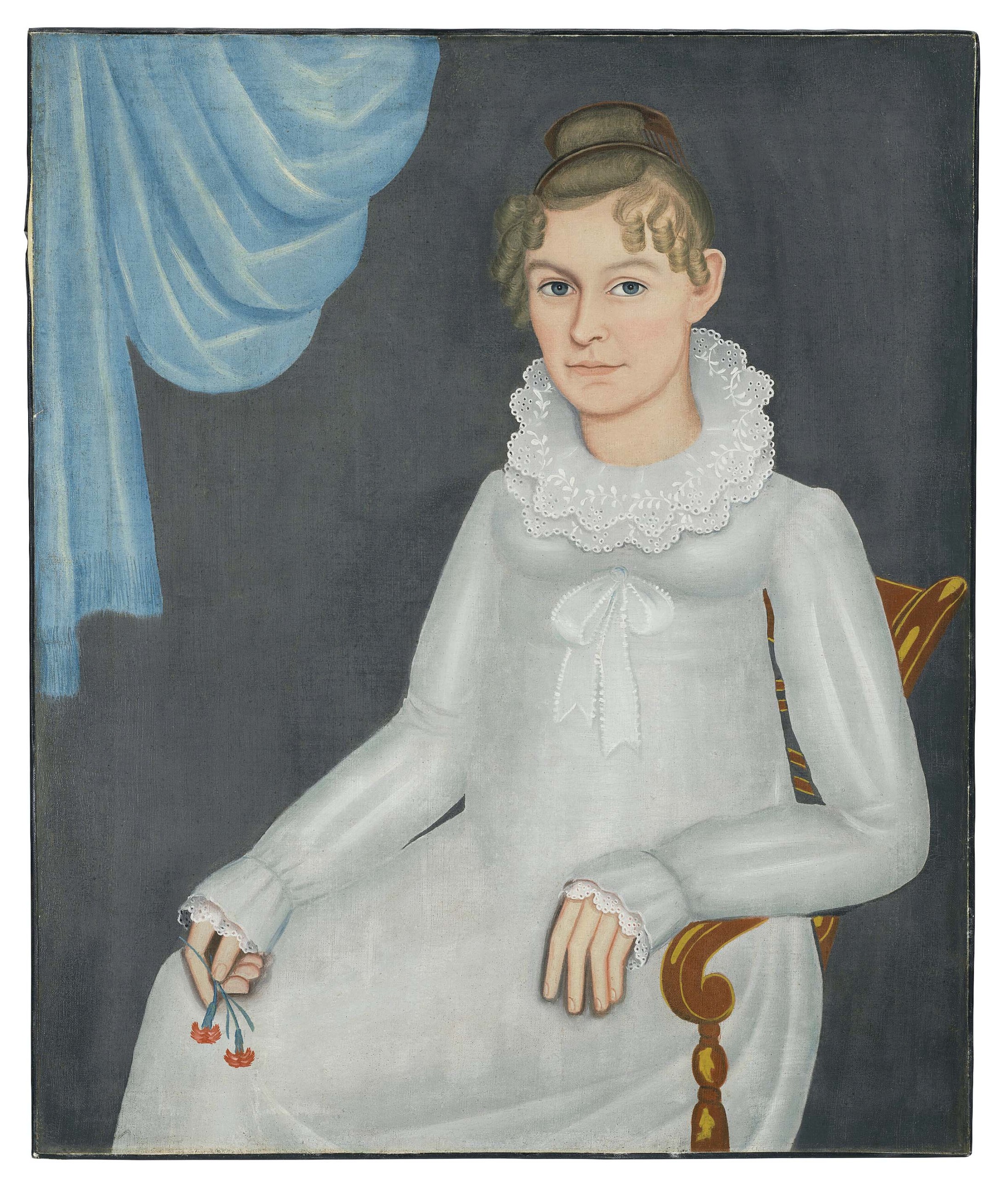
One of more than a half-dozen deals closed by David A. Schorsch was this oil on canvas portrait of Ruth (Haynes) Palmer, painted by Ammi Phillips in Hoosick, N.Y., circa 1816-18, that measured 36 by 30 inches. David A. Schorsch & Eileen M. Smiles Fine Americana, Woodbury, Conn.
“In our second year at the fair, we again presented an exhibition of 20 select works titled, ‘Classic American Folk Art, 1800-1930,’ accompanied by an online flipbook catalog. We sold a number of works in a broad price range to long-term and new clients, and one major picture went to a dealer. It is rewarding for those of us who love and respect traditional American folk art to have it appreciated by the wider marketplace alongside the best American fine art in the company of such distinguished colleagues. We are honored to be a part of this jewel box of a show.”
Debra Force Fine Art and Alexandre Gallery were showing on either side of Schorsch and both had imposing bronze figures in their booths. The former offered Frederick W. MacMonnies’ (1863-1937) 27½-inch-tall “Nathan Hale” (1890), while the latter showcased “Standing Woman in Pleated Skirt” by Gaston Lachaise (1882-1935), numbered 8 from an edition of 10 cast in 1928 that stood 15¾ inches tall.
Meredith Ward, Force’s other neighbor, had made two sales two days into the show: “Seated Figure,” a sinuous abstracted bronze by Alexander Archipenko (Ukrainian/American, 1887-1964) and Charles Burchfield’s (1893-1967) 1920 watercolor on paper composition, “Red Sun.”
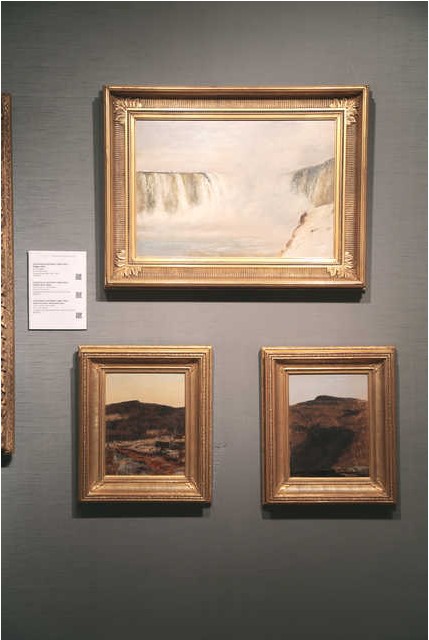
Hawthorne Fine Art was showing these three oil on paper or cardstock landscapes by Lockwood de Forest (1850-1932). At the top, “Niagara Falls” from 1877, “Hudson River Valley” and “South Mountain, Kaaterskill Clove,” both from 1875. New York City.
The third floor was split into two galleries: to one side were Adelson Galleries, Dolan Maxwell and Hawthorne Fine Art. Schwarz Gallery, D. Wigmore Fine Art, Graham Shay 1857 and Kraushaar Galleries held court on the other side of the floor.
A few things with Schwarz Gallery sported red “sold” dots halfway through the run of the fair: Anna Richards Brewster’s (1870-1952) “Flowers Against a Red Background,” “Dewey Arch, Madison Square, N.Y.” by Hughson Hawley (1850-1936) and Jane Peterson’s (1876-1965) “Portrait of a Woman” all found new homes.
Cameron Shay had been busy over the weekend and the booth of Graham Shay 1857 evidenced the result of his labors with “sold” stickers on several things. All media traded hands, from the oil on canvases of James D. Smillie’s (1833-1909) “The Yosemite Valley” and an abstracted seascape by Edwin Dickinson (1891-1978) to Jane Peterson’s gouache and charcoal on paperboard composition, “Bridge of Sighs,” to the imposing bronze works of Helen Mears (1872-1916) and Henry Kirke Brown (1814-1886). A representative for the New York City gallery confirmed they had brokered deals with both new and existing clients.
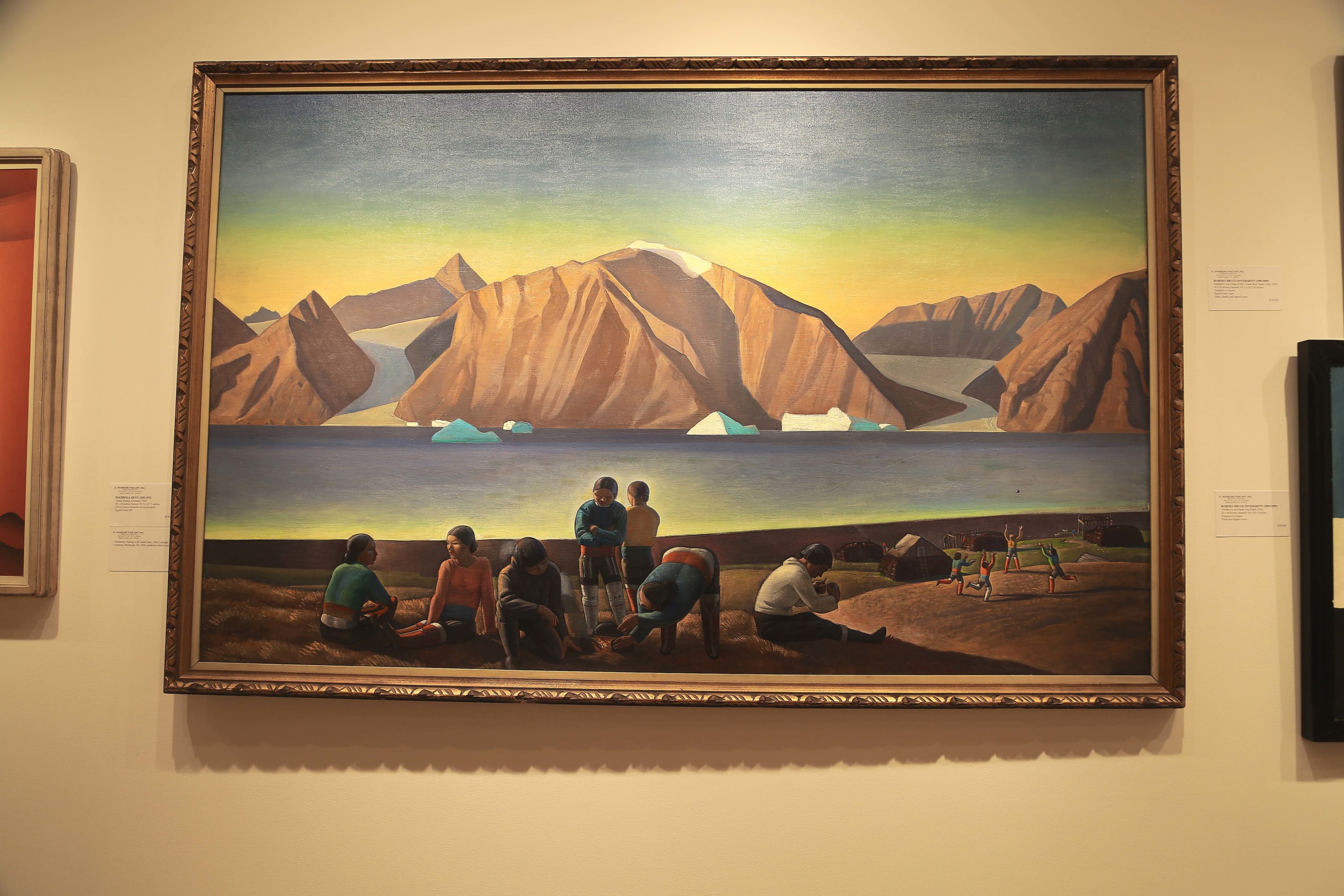
“Sunday Evening, Greenland,” by Rockwell Kent (1882-1971), 1944, oil on canvas, 40 by 64 inches, framed 43¾ by 67¾ inches. D. Wigmore Fine Art, Inc., New York City.
Deedee Wigmore’s sunny booth between Schwarz Gallery and Graham Shay 1857 had a broad range, from Rockwell Kent (1882-1971) to George Morris (1905-1975) and John Marin (1870-1953). Of significance was their selection of works by modern Native American artists Quincy Tahoma (Navajo, 1920-1956) and Otis Polelonoma (Hopi, 1902-1981).
Flowers were abundant in two works sold by Kraushaar Galleries. “Spring” by Ernest Lawson (1873-1939) from 1912 was one of them; the other was the 1991 oil on canvas composition by John Heliker (1909-2000) titled “Still Life with Flowers in a White Vase.”
Venice was a minor theme in the works Adelson Galleries brought to the fair, showing a 1904 watercolor by John Singer Sargent and another watercolor by Maurice Prendergast (1858-1924) titled “The Gondolas, Venice.” Other works that stood out included two portraits by Sargent, Andrew Wyeth’s “Hunter’s Lodge” watercolor from 1988 and a vibrant painted leather composition by Winfred Rembert (1945-2021) that was untitled but depicted a classroom interior.
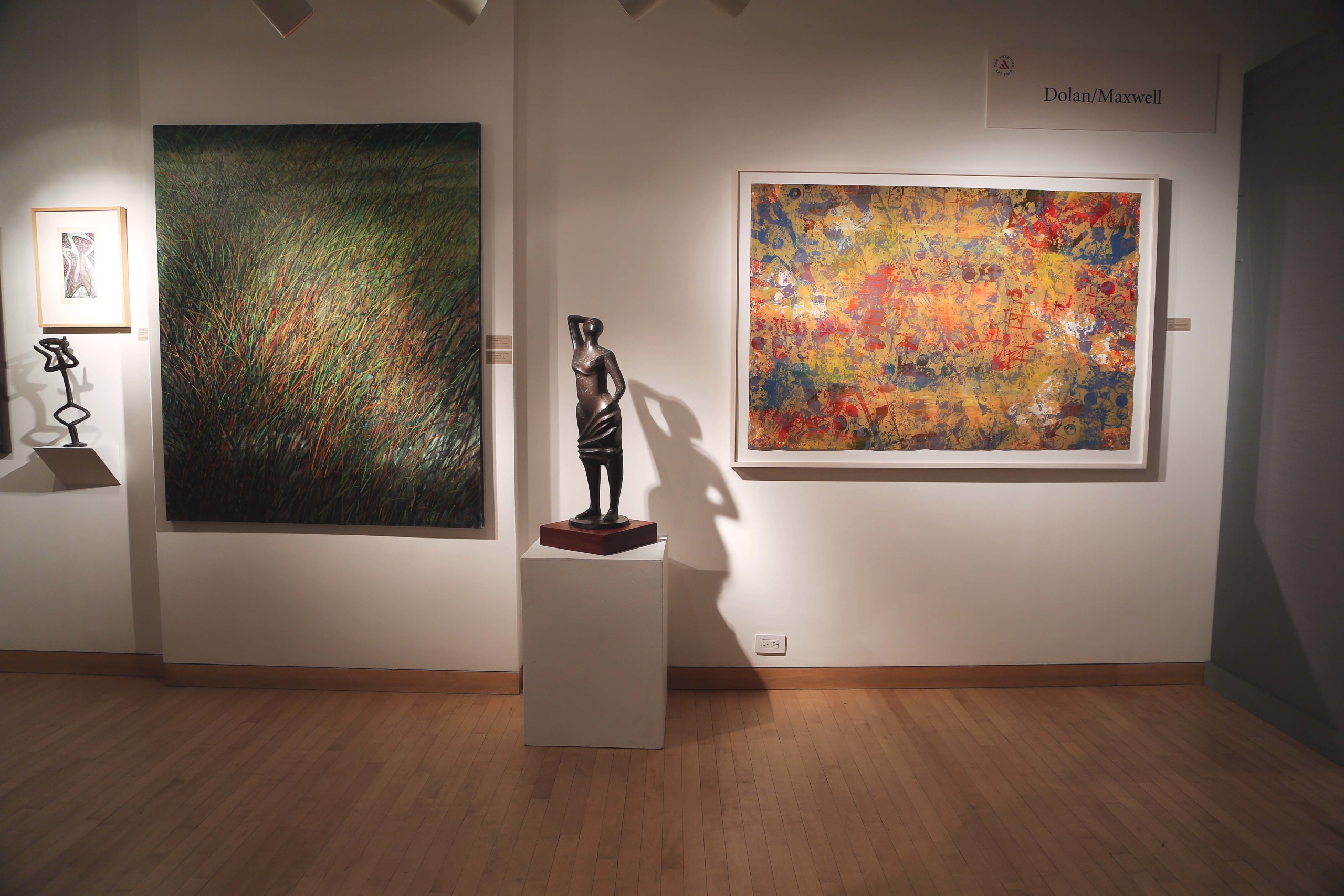
From left, “Vertical Wetland” by Gabor Peterdi (Hungarian/American, 1915-2001), 1979, oil on canvas; Elizabeth Catlett’s (American, 1915-2012) imposing 2007 bronze “Standing Strong”; and, from 1974, “Miles Axe” by Sam Gilliam (b 1933). Dolan/Maxwell, Philadelphia.
African American artists were out in force with Philadelphia dealer Dolan/Maxwell, who brought works by Dox Thrash (1893-1965), the subject of an exhibition they are currently presenting. Also on view was a vibrant floral still life by Laura Wheeler Waring (1887-1948), a member of the Harlem Renaissance whose works are included in the Metropolitan Museum of Art’s current exhibition. Two works by Grafton Tyler Brown (1841-1918) and Henry Ossawa Tanner (1859-1937) were also pointed out to us by assistant director, Jon Eckel.
Hawthorne Fine Art sold two recently acquired works by Fidelia Bridges (1834-1923) and “Sunset near Conway, N.H.” by Albert Bierstadt, which was new to the New York City gallery. Two additional pictures — “The Old Pippin Tree” by Lemuel Maynard Wiles (1826-1905) and Alexander S. Lawrie’s (1828-1917) “Woodland Interior” — will be moving to new walls after the fair.
The 2025 edition of The American Art Fair is scheduled for May 10-13. For information, www.theamericanartfair.com.

























